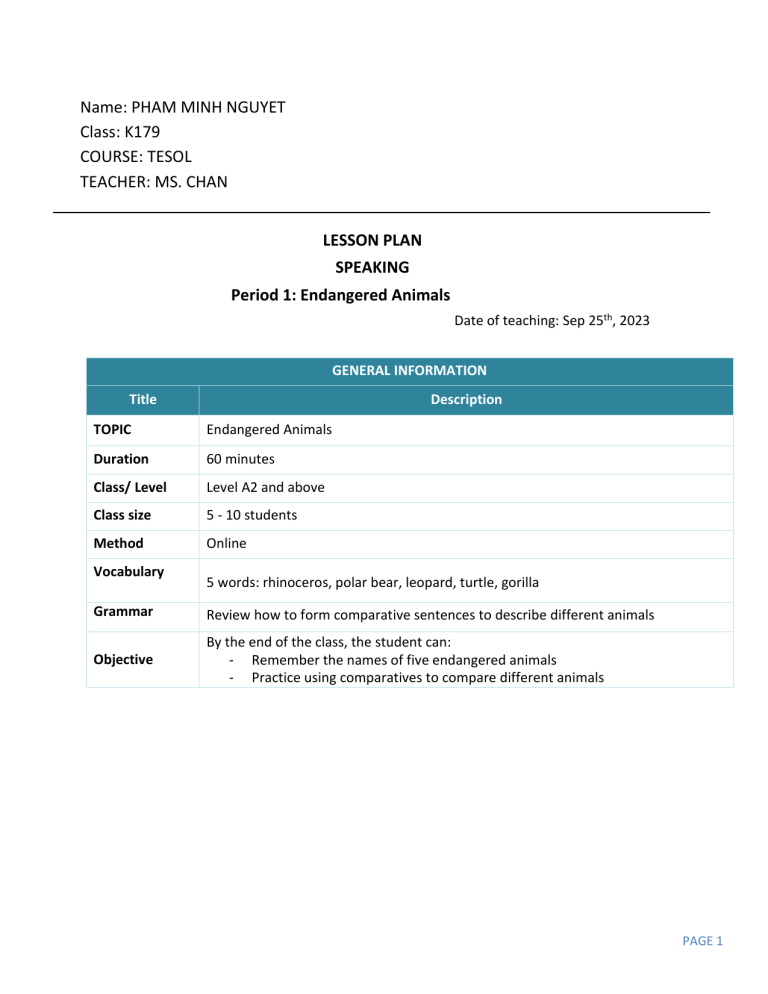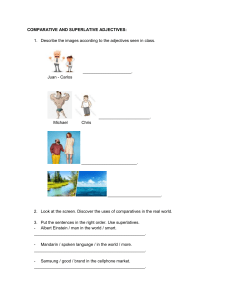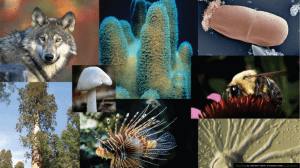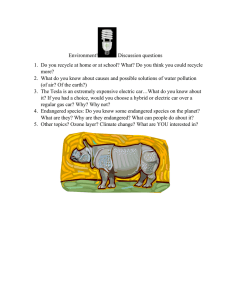
Name: PHAM MINH NGUYET Class: K179 COURSE: TESOL TEACHER: MS. CHAN LESSON PLAN SPEAKING Period 1: Endangered Animals Date of teaching: Sep 25th, 2023 GENERAL INFORMATION Title Description TOPIC Endangered Animals Duration 60 minutes Class/ Level Level A2 and above Class size 5 - 10 students Method Online Vocabulary 5 words: rhinoceros, polar bear, leopard, turtle, gorilla Grammar Review how to form comparative sentences to describe different animals Objective By the end of the class, the student can: - Remember the names of five endangered animals - Practice using comparatives to compare different animals PAGE 1 TEACHING PROCEDURE Activities Warm up Presentation 1 Time 5’ 5’ Purpose Introduce the lesson Teacher’s and students’ activities Teacher: + Play a video songs about endangered animals + Make sure that students understand what ‘endangered’ means + Ask them what animals appear on the video that they can remember + Ask students to guess the topic of today’s lesson Students: + Watch the video + Actively participate by naming the animals they remember + Take turns guessing what the topic of today's lesson might be based on the video. Teacher: + Show pictures of five animals. + In each picture, tell students to fill in the missing words in the name of the animal. + Ask students to share their answers and discuss the meanings of the new vocabulary Introduce new vocabulary about words. + Provide definitions and examples of each endangered word to ensure understanding. animals Students: + Pay attention to the given pictures. + Try to fill in the missing words in the name of each animal. +Volunteer to share their answers and discuss the meanings of the new vocabulary words. + Takes note of the definitions and examples provided for each word. Material - PPT slides - YouTube video: here PPT slides PAGE 2 Practice 1 Presentation 2 10’ 10’ Practice pronouncing new vocabulary Introduce some Adjectives and Review Comparative structure Teacher: + Show each word, along with phonetics, audio and pictures. + Read out loud each word and repeat it at least 2 times + Call students to pronounce each word loudly. + Correct their mistakes. + Ask them what each word means. Students: + Listen carefully to the audio of each word + Pay attention to the phonetics and try to mimic the correct pronunciation. + Pronounce the words out loud, following the teacher's example. + Take note of any difficult words or sounds that they struggle with. + Give translations of these words in their native language. Teacher: + Show students some common Adj + Read out the adjectives and check understanding by suggesting different animals that can be described using each adjective, e.g. scary – snakes, tigers, etc. + Pick 2-3 students to pronounce the words and correct them if any mistakes. + Ask, ‘Are leopard big or small?’ (small). ‘Are they bigger or smaller than turtle?’ (smaller). + Read out the example sentence and review how to form comparatives if necessary, e.g. adding -er if short adjectives, more + adjective if longer, etc. Students: + Participate in giving different animals that are appropriate to the given adjectives. + Practice pronouncing the adjective and correct any mistakes. + Answer the questions about the size PPT slides, audios and pictures. PPT slides PAGE 3 of leopards compared to turtles. + Take notes on new adjectives and comparatives structures if necessary. Practice 2 Production 15’ 10’ Use comparatives to compare different animals. Practice using new vocabulary related to endangered animals and comparative sentences Teacher: + Show pictures of the five animals introduced in Presentation 1. + Ask students to write five sentences using comparative structure to compare different animals. + Call students to read five sentences aloud. PPT slides + Ask other students to correct their and pictures friend’s mistakes if any + Feedback on each student's answer Students: +Write five sentences in comparative structure with the given adjectives. + Read the sentences aloud and ask classmates to correct any mistakes. + Receive feedback on each sentence from the teacher. ACTIVITY 1: GAME CHARADES (GROUP WORK) + Divide the class into two teams and nominate one captain for each team. + Explain the rules of the game: Each team will take turns acting out or describing the endangered animals given by the teacher without directly saying that word. The other team will have to guess what they are acting out within a certain time limit. The team with the most correct guesses PPT slides wins the game. + Suggest students use comparatives to describe + Send a private message of the hidden vocabulary to the captain. + Give each team 10 seconds to listen to the captain and another 10 seconds to type the possible answer in a chat box. + Reveal the correct answer and award points to the team that guessed correctly. PAGE 4 ACTIVITY 2: DEBATES AND DISCUSSIONS (PAIR WORK) + Display the question: If you have the choice to save one among five given animals, which would you save? Why? + Ask them to work in pairs in breakout rooms to discuss their opinions and reasons for choosing a specific animal to save. + Encourage them to use persuasive language and provide evidence to support their arguments. + Bring the pairs back together and have a few volunteers share their opinions with the whole class. Wrap up 5’ Get students to look back at what they learned WATCH A VIDEO + Ask the students to view a video about some endangered animals around the world. + After watching the video, ask them to reflect on what they have learned and - PPT slides their opinions about the importance of - YouTube protecting these animals. video: here HOMEWORK + Instruct students to record a video (2–3 minutes) giving facts about one endangered animal that they like. + Ask students any possible questions they may have regarding the lesson content. + Finish class PAGE 5



